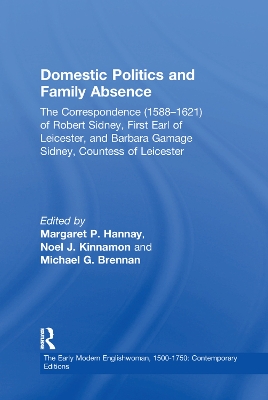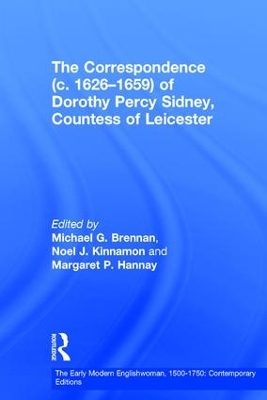The Early Modern Englishwoman, 1500-1750: Contemporary Editions
2 total works
Though all but three of Robert Sidney's 332 extant letters to his wife Barbara Gamage Sidney have been in the Sidney family archive, they have never previously been fully transcribed or edited. This edition of the surviving letters, which Sidney wrote to his wife when they were separated for long periods by his official duties at various continental locations, provides a wealth of information about the Sidneys' family life. They touch on matters such as family illnesses, the children's education, court gossip, finances, and the construction of additions to Penshurst Place, the seat of the Sidney family. The letters also offer an extraordinary record of an early-modern English household in which the wife was entrusted with the overall responsibility for the well-being of her family, and for managing a large estate in the absence of her husband. Sidney's letters show that, although his union with the wealthy Welsh heiress Barbara Gamage may have been engineered primarily for political and financial ends, clearly the couple enjoyed a happy and loving marriage. Their correspondence is full of endearments, and Robert frequently tells his wife how much he misses her and their beloved children, including his 'Malkin,' later Lady Mary Wroth. The volume includes an introduction and notes by the editors. It also includes contextual materials such as relevant sections on family matters from letters to Robert from his trusted agent, Rowland Whyte; and from Robert Sidney's own business correspondence. The introduction specifically addresses the issue of Barbara's literacy, within the broader context of late-Elizabethan women's literacy.
The Correspondence (c. 1626-1659) of Dorothy Percy Sidney, Countess of Leicester
by Michael G Brennan and Noel J Kinnamon
Published 28 October 2010
The letters of Dorothy Percy Sidney, Countess of Leicester, dating predominantly from about 1636 until 1643, cover a wide range of issues and vividly illustrate her centrality to her illustrious family's personal and public affairs. These c.100 letters are here for the first time fully transcribed and edited. The edition includes a biographical and historical introduction, setting the context of the Sidneys' family and political activities at the time of Dorothy's marriage to Robert in 1615 and then tracing the major events and involvements of her life until her death in 1659. A key to the cipher used in the letters to disguise identities of individuals is also supplied. Following the introduction is the complete text of each of Dorothy Percy Sidney's letters to her husband, Robert, second Earl of Leicester, and to and from William Hawkins, the Sidney family solicitor, along with several others, including letters from Dorothy to Archbishop Laud and the Earl of Holland. Her husband's account of her last moments in 1659, and testamentary directions relating to her will, are also included. The letters are arranged in chronological order and supported by a series of footnotes that elucidate their historical context and briefly to identify key individuals, places, political issues and personal concerns. These notes are further supported by selective quotations from Dorothy's incoming correspondence and other related letters and documents. A glossary supplies more detailed information on 'Persons and Places.' Dorothy Percy Sidney's letters eloquently convey how, even with her undoubted personal potency and shrewd intelligence, the multifaceted roles expected of an able and determined aristocratic early modern Englishwoman-especially when her husband was occupied abroad on official business-were intensely demanding and testing.

